Are you wondering if smaller Vietnamese markets offer a less crowded experience compared to the bustling Bac Ha market? Absolutely, exploring alternative markets can provide a more intimate glimpse into local culture. SIXT.VN is here to guide you through Vietnam’s hidden gems, ensuring a memorable and comfortable journey. Discover quieter, equally captivating markets and plan your unique adventure today!
Table of Contents
- What Makes Bac Ha Market So Popular?
- Why Consider Smaller Markets?
- Which Markets Offer a Less Crowded Experience?
- What to Expect at a Smaller Vietnamese Market?
- How to Prepare for Your Market Visit?
- What are Some Essential Vietnamese Phrases for Market Visits?
- Where Can You Find Authentic Local Products?
- What Are the Best Times to Visit These Markets?
- How Can SIXT.VN Enhance Your Market Experience?
- What Other Attractions are Near These Markets?
- What Safety Precautions Should You Take at Local Markets?
- Are There Any Cultural Etiquette Tips to Keep in Mind?
- What Types of Food and Drink Can You Find?
- How Do Prices Compare Between Bac Ha and Smaller Markets?
- Are There Any Special Events or Festivals Held at These Markets?
- What is the Best Way to Get to These Markets?
- Can You Haggle at These Markets?
- What Souvenirs Should You Buy?
- How Do These Markets Support Local Communities?
- What is the Future of Traditional Markets in Vietnam?
- FAQ: Visiting Local Markets in Vietnam
1. What Makes Bac Ha Market So Popular?
Bac Ha Market’s popularity stems from its vibrant cultural showcase and unique offerings. This market, located in the Lào Cai province, is renowned for its lively atmosphere and authentic ethnic minority culture.
The Bac Ha Market is famous for several reasons:
- Cultural Significance: It is a hub for the Flower H’mong people and other ethnic minorities, showcasing their traditional clothing, crafts, and customs.
- Animal Trading: The market features a lively animal section where locals buy, sell, and trade livestock, including water buffaloes, horses, and pigs.
- Handicrafts: Visitors can find a wide array of handmade textiles, jewelry, and other unique souvenirs.
- Local Cuisine: The market offers a variety of local dishes and drinks, providing a taste of authentic Vietnamese cuisine.
- Photogenic Scenery: The colorful clothing, bustling activity, and scenic backdrop make it a photographer’s paradise.
However, its popularity also means it can get very crowded, especially on Sundays. According to the General Statistics Office of Vietnam, Lào Cai province has seen a steady increase in tourism, contributing to the market’s congestion.
2. Why Consider Smaller Markets?
Smaller markets offer a more intimate and authentic cultural experience, away from the large crowds typically found at Bac Ha. These markets provide a chance to connect with local vendors and observe daily life without the overwhelming tourist presence.
Here are several reasons to consider smaller markets:
- Less Crowded: Enjoy a more relaxed and personal experience with fewer tourists.
- Authenticity: Experience a more genuine glimpse into local culture and traditions.
- Unique Products: Discover unique, locally-made goods that might not be available in larger markets.
- Direct Interaction: Engage in more meaningful conversations with local vendors.
- Supporting Local Economy: Your purchases directly support the local community.
Smaller markets often reflect the specific character of the region they serve. For instance, a market in a rice-growing area might specialize in agricultural tools and produce, while one near a craft village could offer intricate handmade items.
3. Which Markets Offer a Less Crowded Experience?
Several markets in Northern Vietnam provide a more serene alternative to Bac Ha. These include Coc Ly Market, Sin Cheng Market, and Muong Hum Market, each offering unique cultural experiences and local products.
- Coc Ly Market: Situated near the Chay River, Coc Ly Market is smaller and less touristy than Bac Ha. It attracts mainly the Flower H’mong and Black Dao ethnic groups. The market is held every Tuesday. You can also take a boat trip on the Chay River, adding to the experience.
- Sin Cheng Market: Located further north, near the Chinese border, Sin Cheng Market is held every Wednesday. It’s known for its authentic atmosphere and the diverse ethnic groups that gather there. You can find local produce, livestock, and traditional clothing.
- Muong Hum Market: This market, held every Sunday, offers a similar experience to Bac Ha but on a smaller scale. It’s a great place to see the colorful clothing of the local ethnic minorities and sample regional cuisine.
According to TripAdvisor, many travelers prefer these smaller markets for their authenticity and less crowded environment.
4. What to Expect at a Smaller Vietnamese Market?
At smaller Vietnamese markets, anticipate a more intimate glimpse into local life, characterized by fresh produce, regional specialties, and direct interactions with vendors. These markets are usually less structured and more reflective of the immediate community’s needs and offerings.
Key things to expect:
- Local Produce: Fresh fruits, vegetables, herbs, and spices sourced directly from nearby farms.
- Regional Specialties: Unique dishes and ingredients specific to the area.
- Handmade Crafts: Locally crafted textiles, basketry, and other artisanal products.
- Lively Atmosphere: A bustling environment filled with the sounds of bartering, laughter, and local chatter.
- Direct Interaction: Opportunities to engage with vendors and learn about their products.
According to a study by the Vietnam National Administration of Tourism, these smaller markets are vital for preserving local culture and traditions.
5. How to Prepare for Your Market Visit?
Preparing for a market visit involves dressing appropriately, bringing essentials like cash and a reusable bag, and researching local customs to ensure a respectful and enjoyable experience. A little preparation can go a long way in making your visit smooth and enriching.
Here’s a checklist to help you prepare:
- Dress Comfortably: Wear lightweight, breathable clothing and comfortable shoes suitable for walking.
- Bring Cash: Most vendors prefer cash, so have a sufficient amount of local currency on hand.
- Reusable Bag: Bring a sturdy bag for your purchases to avoid using plastic bags.
- Sun Protection: Wear a hat and sunscreen to protect yourself from the sun.
- Water: Stay hydrated by bringing a water bottle.
- Learn Basic Phrases: Knowing a few Vietnamese phrases can enhance your interactions with vendors.
6. What are Some Essential Vietnamese Phrases for Market Visits?
Knowing a few basic Vietnamese phrases can significantly enhance your market experience, allowing you to communicate more effectively and respectfully with local vendors. These phrases can help you negotiate prices, ask about products, and express gratitude.
Here are some essential phrases:
| Phrase | Vietnamese | Pronunciation | Meaning |
|---|---|---|---|
| Hello | Xin chào | Seen Chao | Hello |
| How much? | Bao nhiêu? | Bao Niew? | How much? |
| Too expensive | Đắt quá! | Dat Kwa! | Too expensive |
| Can you lower the price? | Bớt được không? | But Duoc Khong? | Can you lower the price? |
| Thank you | Cảm ơn | Cam Un | Thank you |
| Delicious | Ngon quá! | Ngon Kwa! | Delicious |
| Do you have…? | Bạn có…? | Ban Co…? | Do you have…? |
| I want to buy this | Tôi muốn mua cái này | Toy Muon Mua Cai Nay | I want to buy this |
| No, thank you | Không, cảm ơn | Khong, Cam Un | No, thank you |
| Goodbye | Tạm biệt | Tam Biet | Goodbye |
7. Where Can You Find Authentic Local Products?
Authentic local products can be found by venturing deeper into the market, engaging with vendors, and seeking out items unique to the region’s culture and traditions. Look for handmade goods, regional specialties, and products that reflect the local heritage.
Tips for finding authentic products:
- Explore Beyond Main Areas: Wander away from the main tourist areas to find lesser-known stalls.
- Engage with Vendors: Ask vendors about the origin and production of their products.
- Look for Handmade Items: Seek out items that are clearly handmade, showcasing local craftsmanship.
- Check for Local Ingredients: For food items, inquire about the ingredients and their source.
- Visit Early: Arrive early to see vendors setting up and to get the first pick of the day’s offerings.
8. What Are the Best Times to Visit These Markets?
The best times to visit these markets are early in the morning, typically between 7:00 AM and 9:00 AM, to experience the market at its most vibrant and avoid the afternoon crowds. Arriving early allows you to see vendors setting up and get the freshest products.
Here’s why visiting early is beneficial:
- Fresh Products: Vendors have just set up with the freshest produce and goods.
- Fewer Crowds: Enjoy a more relaxed experience before the tourist crowds arrive.
- Best Photo Opportunities: Capture the market’s atmosphere with better lighting and fewer people.
- Engage with Locals: Have more time to interact with vendors and learn about their products.
- Avoid the Heat: Beat the midday heat, especially during the hotter months.
9. How Can SIXT.VN Enhance Your Market Experience?
SIXT.VN enhances your market experience by providing reliable transportation, local insights, and personalized travel assistance. With SIXT.VN, you can enjoy a hassle-free journey to and from the market, tailored to your preferences and needs.
Here’s how SIXT.VN can help:
- Convenient Transportation: Arrange for private car services or airport transfers for a seamless journey.
- Local Insights: Access insider tips and recommendations for the best market experiences.
- Customized Itineraries: Create personalized travel plans that include market visits and other local attractions.
- Multilingual Support: Get assistance in your preferred language for a comfortable experience.
- Reliable Service: Count on SIXT.VN for punctual, safe, and reliable transportation services.
SIXT.VN offers a range of services to make your trip more enjoyable, including car rentals, private drivers, and airport transfers.
10. What Other Attractions are Near These Markets?
Near these markets, you can discover stunning rice terraces, ethnic minority villages, and natural landscapes. Combine your market visit with exploring the surrounding region for a richer cultural and scenic experience.
Here are some attractions near the markets:
- Sapa: Famous for its breathtaking rice terraces and trekking opportunities.
- Fansipan Peak: The highest peak in Indochina, offering panoramic views of the region.
- Cat Cat Village: A traditional H’mong village with unique cultural practices and crafts.
- Love Waterfall: A beautiful waterfall surrounded by lush greenery.
- Ancient Rock Field: An archaeological site with ancient carvings and petroglyphs.
11. What Safety Precautions Should You Take at Local Markets?
At local markets, it’s important to stay vigilant about your belongings, avoid displaying valuable items, and be mindful of your surroundings to ensure a safe visit. Taking basic safety precautions can help you avoid common issues like theft or scams.
Here are some safety tips:
- Keep Belongings Secure: Use a secure bag or money belt to protect your valuables.
- Avoid Displaying Valuables: Don’t flash expensive jewelry or electronics.
- Be Aware of Your Surroundings: Pay attention to people around you and avoid crowded areas if possible.
- Trust Your Instincts: If something feels off, remove yourself from the situation.
- Stay Hydrated: Drink plenty of water to avoid dehydration, especially in hot weather.
- Know Emergency Numbers: Keep a list of emergency contact numbers, including local police and your embassy.
12. Are There Any Cultural Etiquette Tips to Keep in Mind?
Respect local customs by dressing modestly, asking permission before taking photos, and avoiding loud or disruptive behavior. Showing cultural sensitivity enhances your interactions and fosters a positive exchange.
Key etiquette tips:
- Dress Modestly: Avoid revealing clothing out of respect for local customs.
- Ask Permission: Before taking photos of people, ask for their consent.
- Be Polite: Use polite language and avoid being overly assertive.
- Remove Shoes: When entering someone’s home, remove your shoes.
- Use Both Hands: When giving or receiving something, use both hands as a sign of respect.
- Avoid Public Displays of Affection: Keep public displays of affection to a minimum.
13. What Types of Food and Drink Can You Find?
You can find a variety of local delicacies such as pho, banh mi, and regional specialties like thang co (horse meat stew) and “happy water” (corn alcohol). Exploring the food stalls offers a delicious way to experience the local culture.
Popular food and drinks to try:
- Pho: A traditional Vietnamese noodle soup with meat and herbs.
- Banh Mi: A Vietnamese sandwich with meat, vegetables, and pate.
- Thang Co: A traditional H’mong dish made with horse meat and spices.
- Happy Water (Ruou Ngo): A strong corn-based alcohol.
- Nem Nuong: Grilled pork sausage served with rice paper and dipping sauce.
- Fresh Spring Rolls (Goi Cuon): Rice paper rolls filled with vegetables, herbs, and meat or shrimp.
14. How Do Prices Compare Between Bac Ha and Smaller Markets?
Prices at smaller markets are often lower than those at Bac Ha, reflecting the local economy and reduced tourist presence. Haggling is still common, but vendors may be more willing to offer better deals in these less crowded settings.
Here’s a comparison of prices:
- Lower Prices: Smaller markets often have lower prices due to less tourist demand.
- Negotiable Prices: Haggling is common, and you may get better deals compared to Bac Ha.
- Direct Sales: Vendors often sell directly from their farms or workshops, reducing overhead costs.
- Local Economy: Prices reflect the local economic conditions, making it more affordable for both locals and tourists.
15. Are There Any Special Events or Festivals Held at These Markets?
Some markets host special events or festivals, especially during Tet (Lunar New Year) or other local holidays. These events enhance the market experience with traditional performances, games, and unique seasonal offerings.
Special events to look out for:
- Tet (Lunar New Year): Markets become especially festive with decorations, special foods, and traditional games.
- Mid-Autumn Festival: Markets feature mooncakes, lanterns, and lion dances.
- Local Harvest Festivals: Markets celebrate the harvest season with fresh produce and agricultural displays.
- Ethnic Minority Festivals: Markets may host cultural performances and ceremonies specific to local ethnic groups.
16. What is the Best Way to Get to These Markets?
The best way to get to these markets often involves a combination of train or bus to major towns like Lao Cai, followed by a car or motorbike ride to the market location. SIXT.VN can help arrange transportation from major hubs to these smaller markets.
Transportation options:
- Train: Take a night train from Hanoi to Lao Cai, then transfer to a car or motorbike.
- Bus: Several bus companies offer routes from Hanoi to Lao Cai and other nearby towns.
- Car Rental: Rent a car with SIXT.VN for greater flexibility and convenience.
- Private Driver: Hire a private driver for a comfortable and personalized experience.
- Motorbike: Rent a motorbike for an adventurous journey, but be cautious of road conditions.
17. Can You Haggle at These Markets?
Yes, haggling is expected at these markets, but it should be done respectfully and with a friendly demeanor. Start by offering a lower price than the asking price and negotiate to a mutually agreeable amount.
Tips for haggling:
- Be Polite: Maintain a friendly and respectful attitude.
- Start Low: Begin with an offer that is significantly lower than the asking price.
- Be Willing to Walk Away: If the vendor doesn’t agree to your price, be prepared to walk away.
- Know the Value: Research the average price of similar items to gauge a fair offer.
- Use Humor: Injecting humor into the negotiation can ease the tension.
18. What Souvenirs Should You Buy?
Consider buying local handicrafts, textiles, jewelry, or regional food items as souvenirs. These items not only serve as mementos of your trip but also support the local economy and preserve cultural traditions.
Souvenir ideas:
- Handmade Textiles: Embroidered clothing, scarves, and bags made by local artisans.
- Silver Jewelry: Intricate silver necklaces, bracelets, and earrings.
- Handwoven Baskets: Baskets of various sizes and designs made from local materials.
- Local Spices: Unique spices and herbs used in regional cuisine.
- Traditional Musical Instruments: Small instruments like flutes or bamboo xylophones.
- Hand-Painted Pottery: Pottery items with traditional designs and patterns.
19. How Do These Markets Support Local Communities?
These markets provide vital economic opportunities for local communities, allowing them to sell their products, preserve their cultural heritage, and sustain their traditional way of life. By visiting and purchasing goods at these markets, you directly contribute to the well-being of these communities.
Benefits to local communities:
- Economic Empowerment: Markets provide a platform for locals to earn a living.
- Cultural Preservation: Markets help preserve traditional crafts and customs.
- Community Development: Income from markets supports local infrastructure and services.
- Sustainable Livelihoods: Markets promote sustainable practices by supporting local agriculture and craftsmanship.
20. What is the Future of Traditional Markets in Vietnam?
The future of traditional markets in Vietnam depends on balancing preservation with modernization, ensuring they remain relevant and sustainable in the face of changing economic and social landscapes. Efforts to promote tourism, support local vendors, and adapt to modern consumer preferences will be crucial.
Challenges and opportunities:
- Modernization: Adapting to modern retail practices while preserving traditional values.
- Tourism: Balancing tourism with the needs of local communities.
- Sustainability: Promoting sustainable practices and environmental conservation.
- Technology: Using technology to improve market efficiency and reach.
- Community Engagement: Involving local communities in the planning and management of markets.
21. FAQ: Visiting Local Markets in Vietnam
Here are some frequently asked questions about visiting local markets in Vietnam, designed to help you plan your trip and make the most of your experience.
Q1: What is the best time of year to visit these markets?
A1: The best time is during the dry season (October to April) for pleasant weather. However, visiting during local festivals offers unique cultural experiences.
Q2: Are ATMs available near these markets?
A2: ATMs may be limited, especially in more remote areas. It’s best to bring enough cash with you.
Q3: Can I take photos of the vendors and their products?
A3: Always ask for permission before taking photos to respect their privacy and cultural norms.
Q4: Is it safe to eat the street food at these markets?
A4: Choose stalls that appear clean and have high turnover. Opt for cooked foods served hot to minimize the risk of foodborne illness.
Q5: How do I get around the market?
A5: Markets are usually pedestrian-friendly, but be prepared for crowded conditions. Wear comfortable shoes and stay aware of your surroundings.
Q6: What should I do if I don’t speak Vietnamese?
A6: Learn a few basic phrases, use a translation app, or hire a local guide to help with communication.
Q7: Are there restrooms available at the markets?
A7: Restrooms may be basic and require a small fee. Carry tissues and hand sanitizer.
Q8: How can I support the local community when visiting these markets?
A8: Buy directly from local vendors, choose locally-owned businesses, and respect their culture and traditions.
Q9: Are these markets accessible for people with disabilities?
A9: Accessibility may be limited due to uneven terrain and crowded conditions. Plan ahead and inquire about accessibility options.
Q10: What should I wear to these markets?
A10: Dress modestly and comfortably. Wear lightweight clothing, comfortable shoes, and a hat for sun protection.
By choosing smaller markets, you not only avoid the crowds of Bac Ha but also gain a deeper appreciation for Vietnam’s diverse cultures and traditions. Let SIXT.VN assist you in planning your perfect market adventure! Contact us today to explore customized itineraries and reliable transportation options.
Address: 260 Cau Giay, Hanoi, Vietnam
Hotline/Whatsapp: +84 986 244 358
Website: SIXT.VN
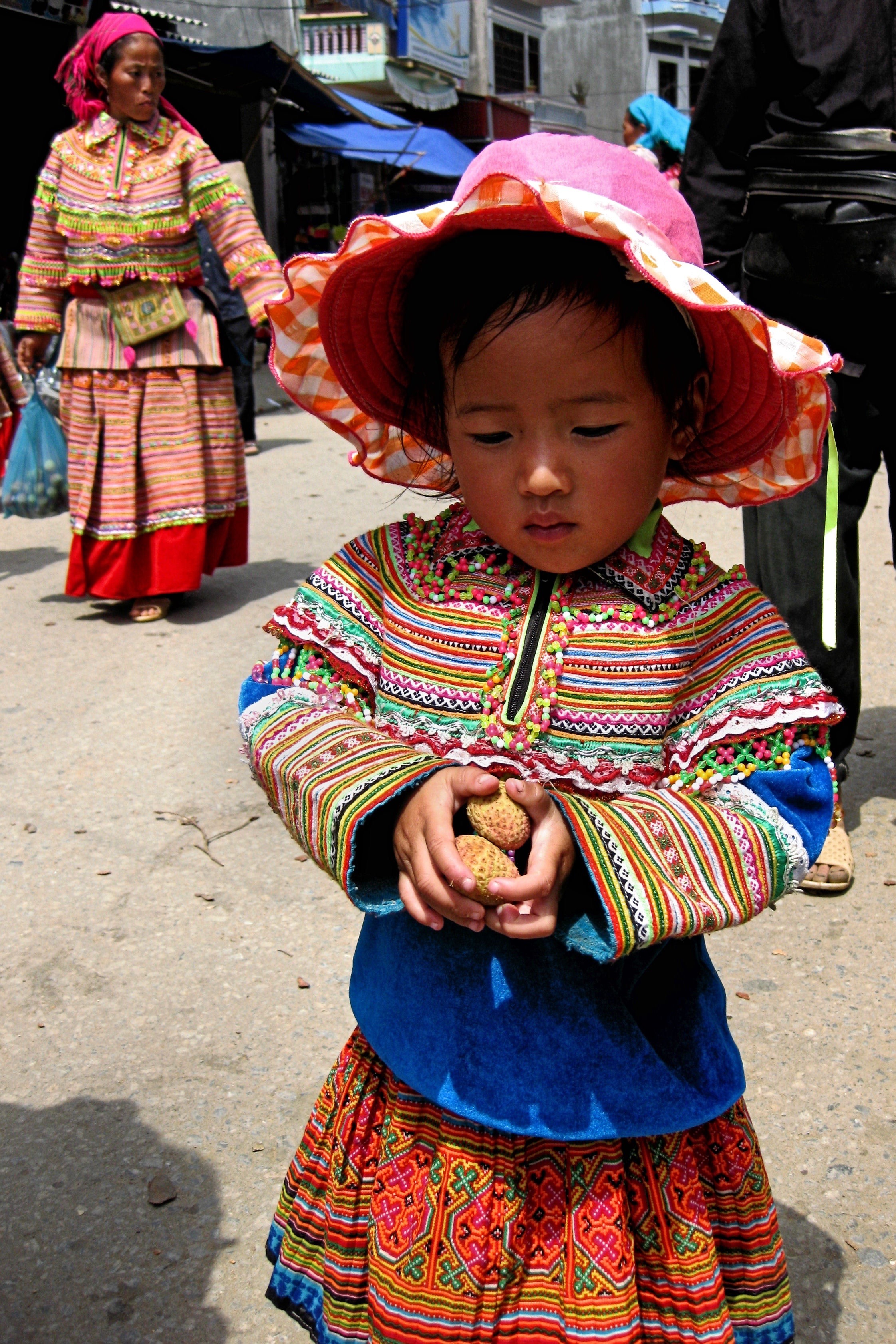 A cute flower H
A cute flower H
A charming Flower H’mong girl showcases the vibrant cultural attire of her community, enriching the market’s colorful tapestry.
 Pedestirans and motor scooters share the market
Pedestirans and motor scooters share the market
Pedestrians and motorbikes navigate the bustling market paths, illustrating the lively blend of commerce and transport in local Vietnamese markets.
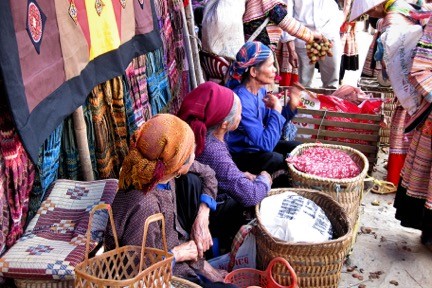 Handcraft vendor women belong to the Tat Hill tribe. Photo by Scott McIntire.
Handcraft vendor women belong to the Tat Hill tribe. Photo by Scott McIntire.
Artisans from the Tay Hill tribe present their meticulously crafted handicrafts, displaying the rich artistic heritage and skills passed down through generations.
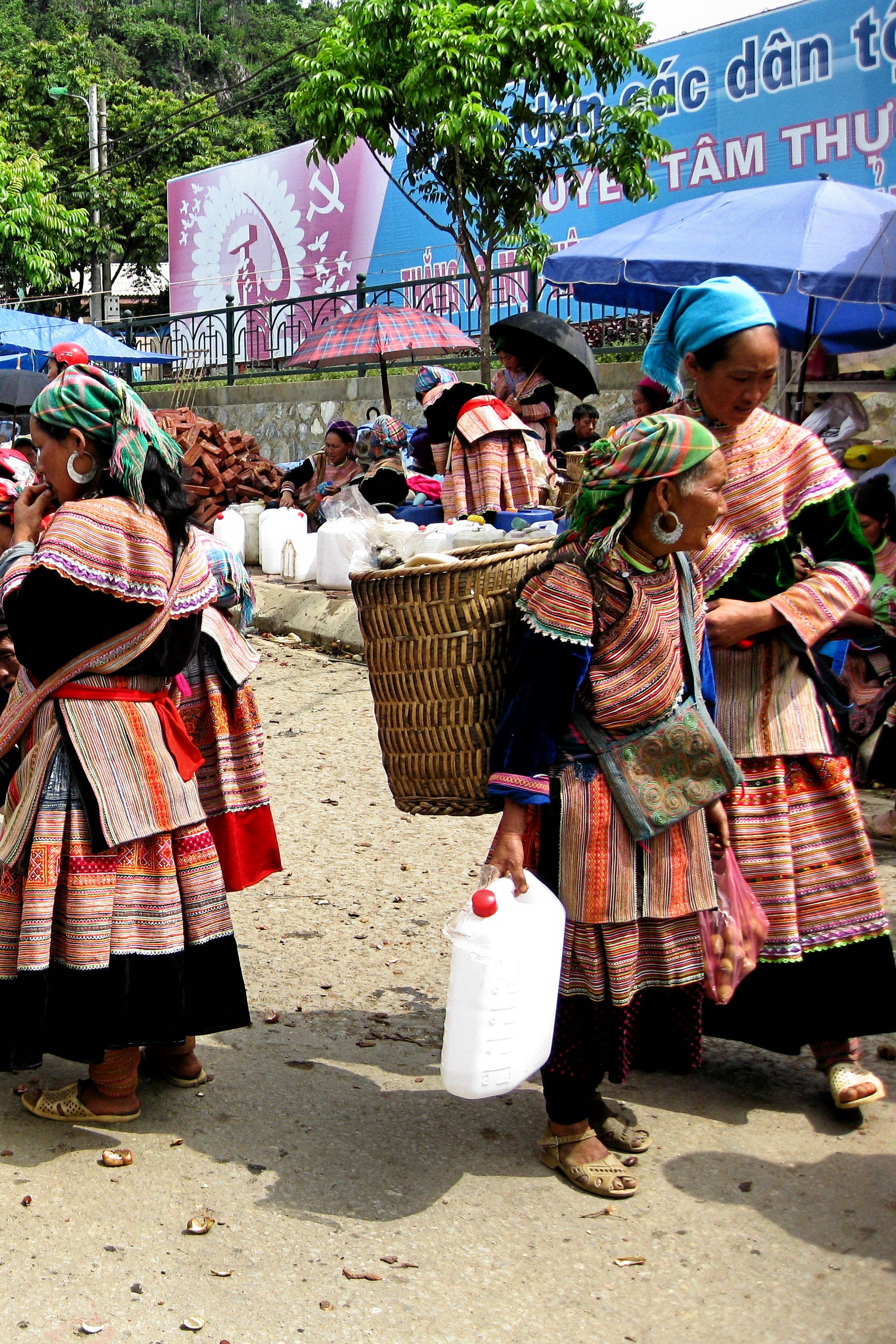
Vendors cheerfully offer “Happy Water,” a local spirit, adding to the festive and convivial atmosphere unique to Vietnamese markets.
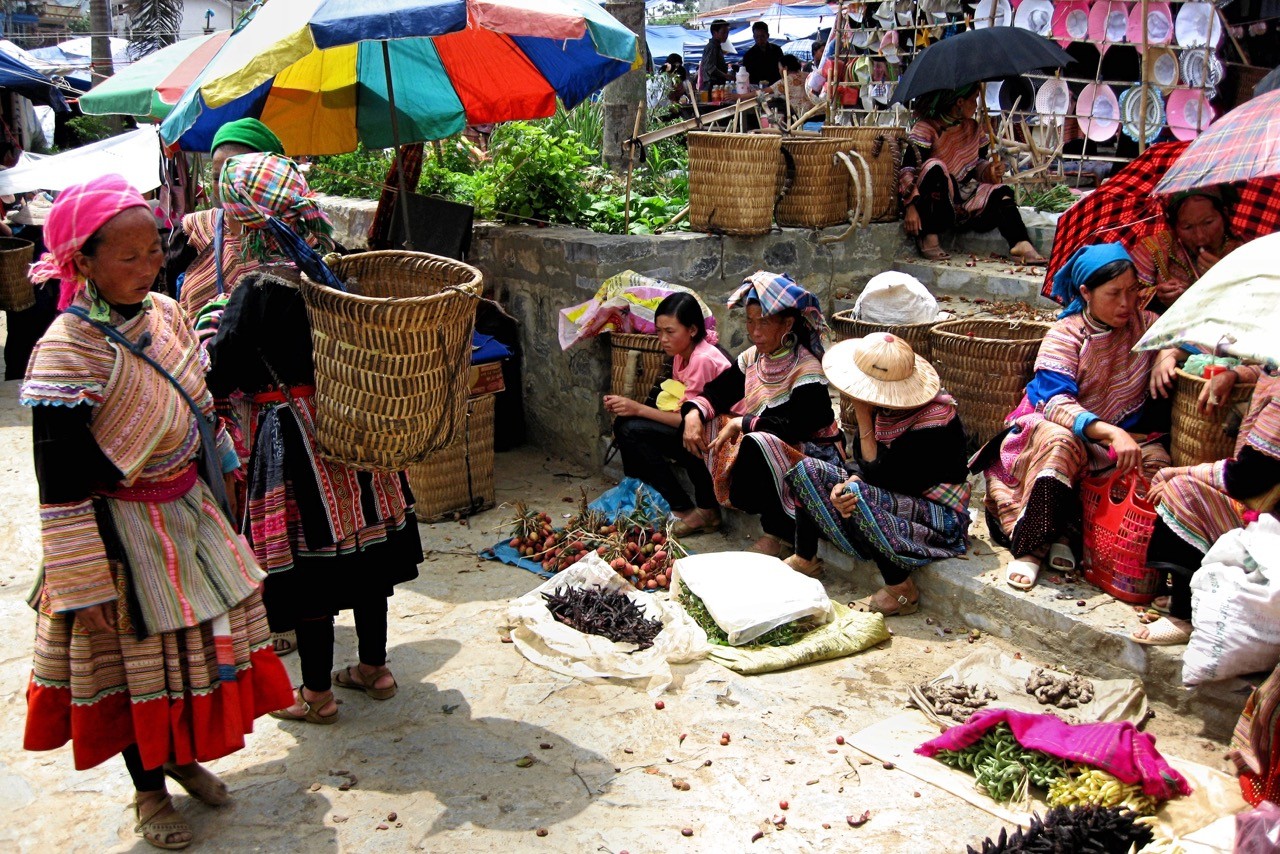 Produce Vendors on the Steps of an Open Courtyard. Photo by Scott McIntire.
Produce Vendors on the Steps of an Open Courtyard. Photo by Scott McIntire.
Local farmers display their fresh produce on the steps of an open courtyard, exhibiting the agricultural bounty and seasonal flavors of the region.
 Flower H
Flower H
Flower H’mong vendor girls share infectious smiles, symbolizing the warmth and welcoming spirit of local Vietnamese markets.
 A live fowl vendor among the handicraft vendors. Photo by Scott McIntire.
A live fowl vendor among the handicraft vendors. Photo by Scott McIntire.
A vendor offers live poultry amidst stalls of handcrafted goods, highlighting the diverse mix of products and activities found in a traditional Vietnamese market.
 The stairway leading up to the market
The stairway leading up to the market
Stairway to the animal trading area showcases the unique integration of livestock commerce within the broader Vietnamese market setting.
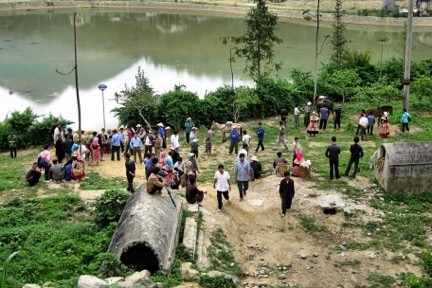 The horse viewing area between the embankment and the Na Co River. Photo by Scott McIntire.
The horse viewing area between the embankment and the Na Co River. Photo by Scott McIntire.
Horses being evaluated for sale in a dedicated area near the river, offering a glimpse into traditional livestock trading practices in Vietnamese culture.
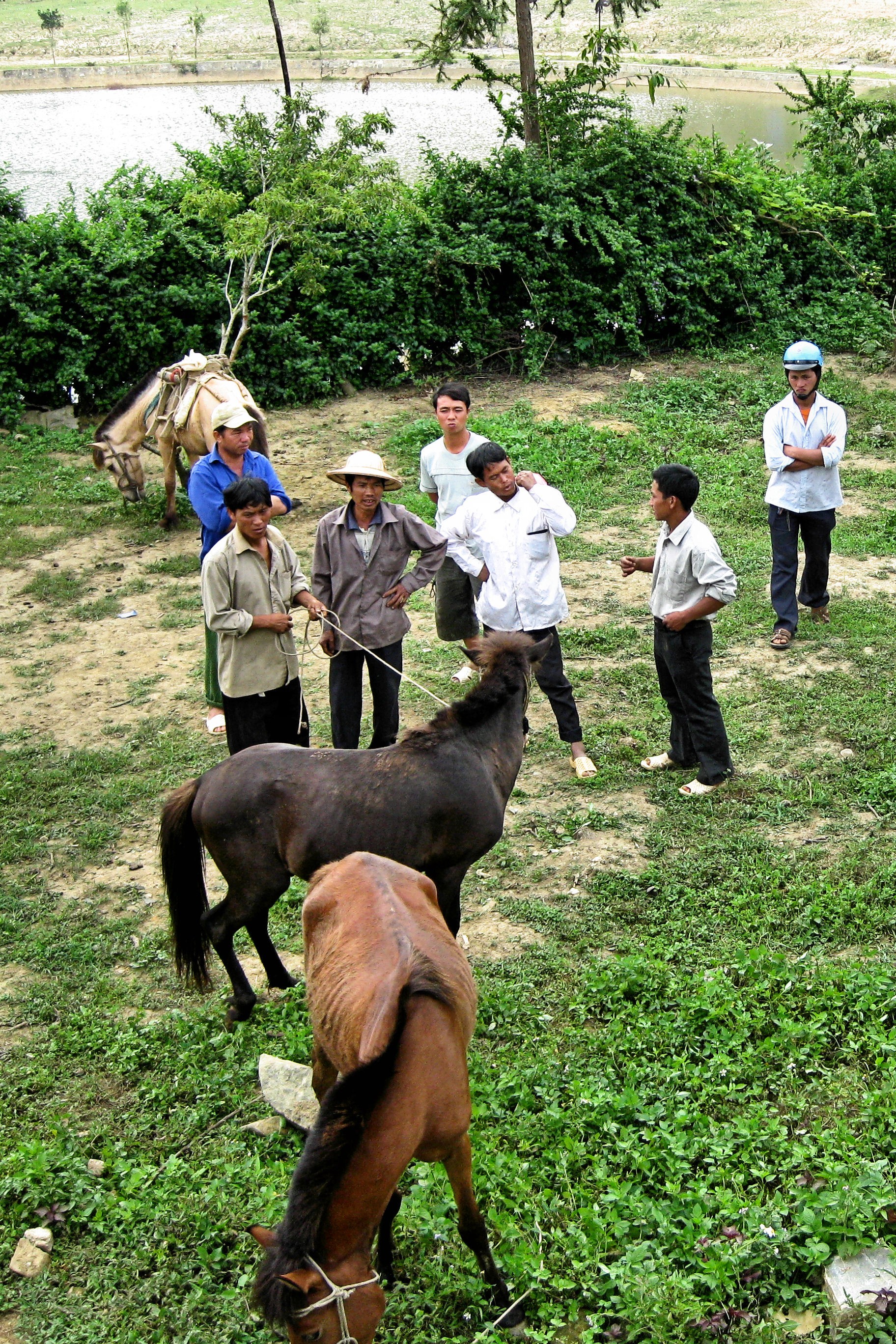 Prospective buyers examine the horses. Photo by Scott Mc Intire.
Prospective buyers examine the horses. Photo by Scott Mc Intire.
Potential buyers closely inspect horses at the market, demonstrating the careful selection process and traditional methods used in animal trading.
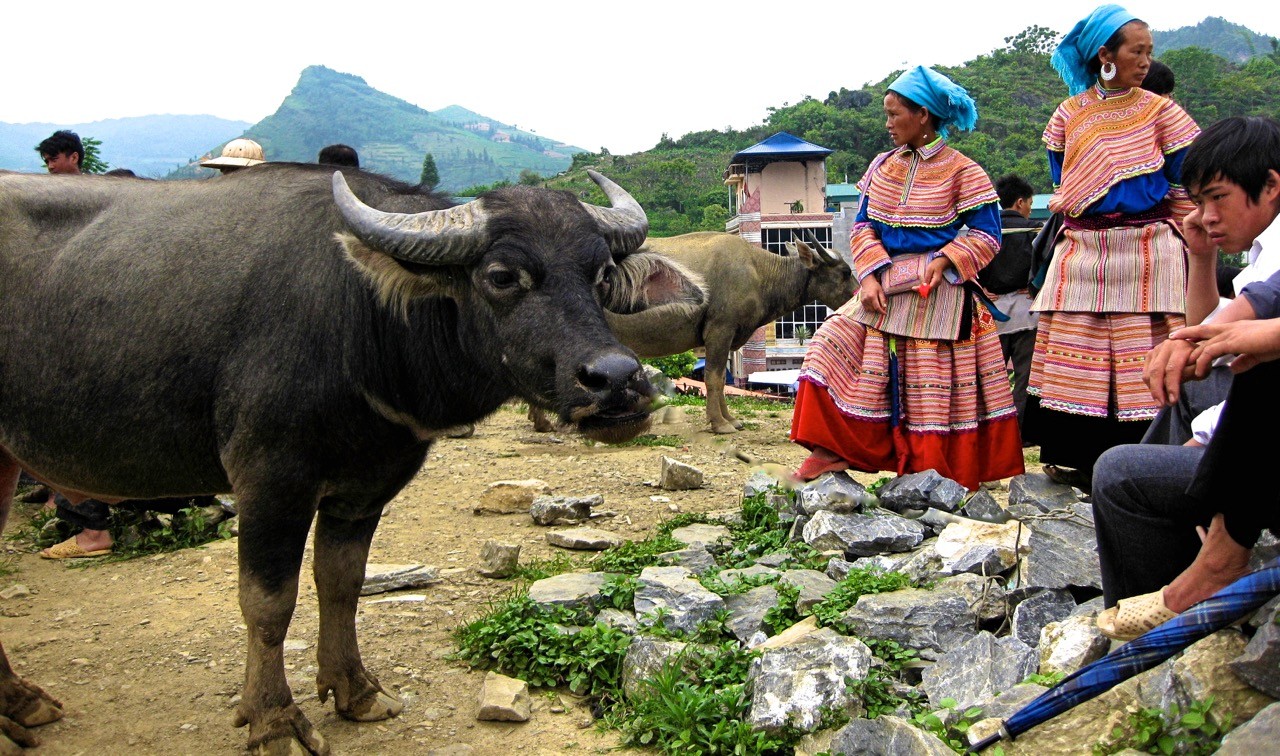 The Water Buffalo Viewing Area at the Bac Ha Sunday Market. Photo by Scott McIntire.
The Water Buffalo Viewing Area at the Bac Ha Sunday Market. Photo by Scott McIntire.
Water buffalo trading area in Bac Ha, a pivotal part of the market, reveals the cultural and economic significance of livestock in Northern Vietnam.



